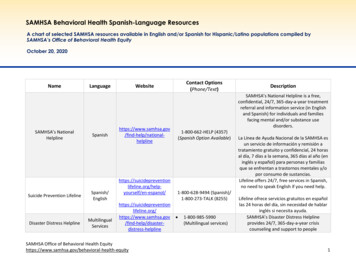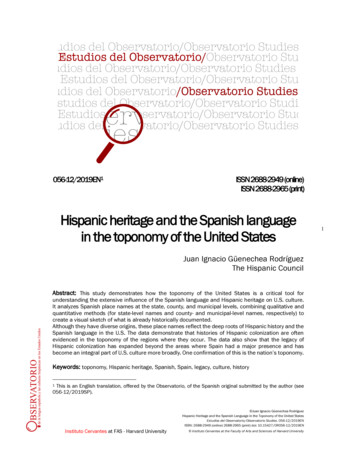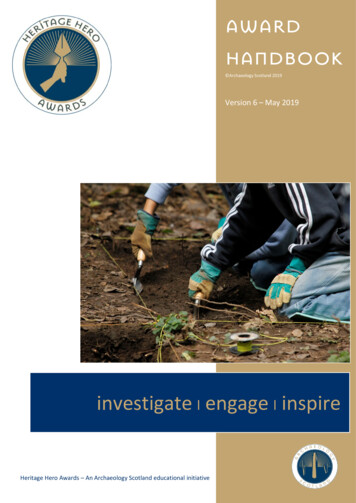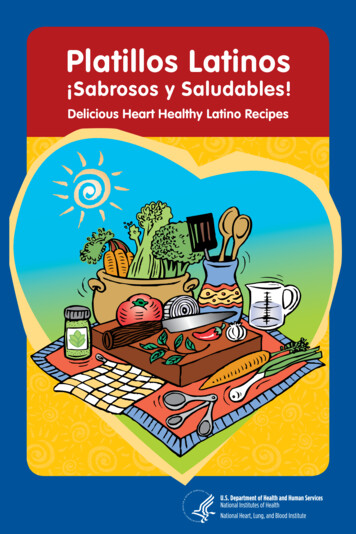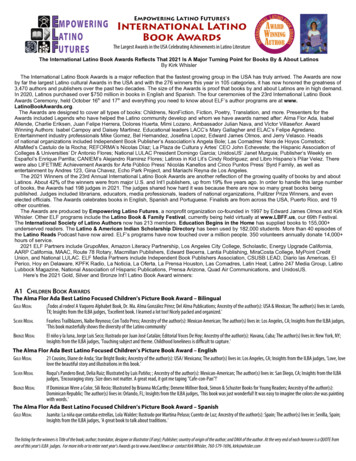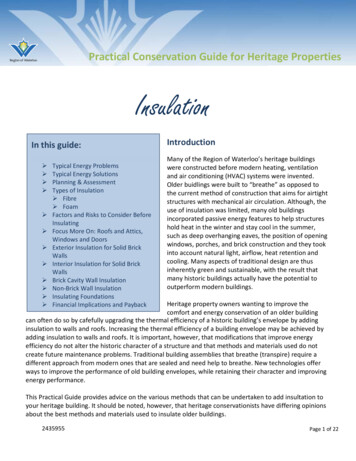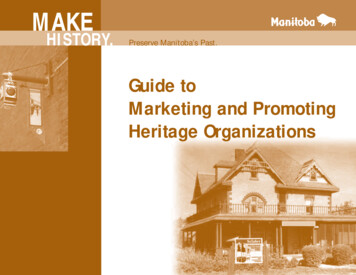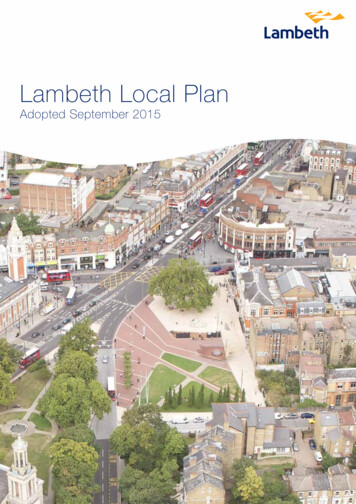
Transcription
Latino/HispanicHeritageResource PacketSeptember 15—October 15
Latino/Hispanic HeritageResource PacketTable of ContentsBeyond Tacos and Mariachis: Making Latino/HispanicHeritage Month MeaningfulPage 3Test Your Knowledge: Latino/Hispanic Heritage Facts QuizPage 5Test Your Knowledge: Immigration Myths and Facts QuizPage 6Test Your Knowledge: Answers to Heritage Facts QuizPage 7Test Your Knowledge: Answers to Immigration Myths andFacts QuizPage 9Teaching IdeaMore Than One: Famous U.S. LatinosPage 10Teaching IdeaPoem: So Mexicans Are Taking Jobs Away From AmericansPage 11Teaching IdeaPoem: Para TeresaPage 12Resource List: Videos, Books, and Web SitesPage 14Background: A Brief History of El SalvadorPage 16Guide prepared by Teaching for Change, www.teachingforchange.org.Artwork by Rini Templeton, www.riniart.orgThis guide was originally produced for use in Washington, D.C., where there is a largeSalvadoran population, yet very little information in schools aboutCentral America. Therefore the guide includes a brief history of El Salvador.Page 2 Compiled by Teaching for Change, www.teachingforchange.orgLatino/Hispanic Heritage Resource Guide
Beyond Tacos and Mariachis:Making Latino/Heritage Month MeaningfulSchool preparations for La-2. Recognize the long historyof Latinos in the United Statesand their great diversity.tino/Hispanic Heritage monthoften include finding performers, scheduling cultural events,coordinating assemblies, andplanning special menus for thecafeteria. Pulling together theseevents can take a lot of time outof teachers' already overloadedschedules.But what do these eventsaccomplish? Ironically, typicalheritage month programs andcelebrations may do as much toreinforce stereotypes as they doto challenge them. It is important to acknowledge marginalized histories, but specialevents in isolation can affirmstereotypes rather than negatethem. If the events are limited toperformances and food, for example, we might be left with theimpression that "Latinos onlylike to dance and eat."We can challenge ourselvesto go deeper. In the same waythat educational reform has recognized the benefit of instruction that is holistic and interdisciplinary, a similar approach iscalled for in addressing culturalheritage. The following aresome points to consider whenplanning Latino/Hispanic heritage events for your school.Latino/Hispanic Heritage Resource Guide1. Determine what you wantstudents to learn from the heritage celebrations.Spend the first meeting preparing a list of instructional objectives — what is it that you wantthe school body to learn fromthese events? Too often we skipthis step and go directly todrawing up a list of possiblepresenters. In developing the listof instructional objectives,spend some time asking students and parents of Latino/Hispanic heritage what theywould like their peers to understand about their heritage. Thebroader school community canprovide useful input to identifying the stereotypes that need tobe addressed and suggestionsfor addressing these issues.There is a tendency to treat allLatinos as immigrants, when inreality Latinos have been on thisland since before the pilgrims.There is also great diversityamong Latinos in terms of ethnic heritage, religion, class, national origin, language, politicalperspectives, and traditions.There are Latinos of African,European, indigenous, andAsian heritage. Be sure that images of Latinos in the classroomreflect this rich diversity.3. Address the values, history,current reality, and power relationships that shape a culture.Heritage months frequently feature the crafts, music, and foodof specific cultures. Whilecrafts, music, and food are important expressions of culture,in isolation they mask the obstacles that people of color havefaced, how they have confrontedthose obstacles, the great diversity within any cultural group,and the current reality of peoplein the United States. A few excellent titles are: Open Veins ofLatin America (Galeano), Occupied America (Acuña), or(Continued on page 4)Compiled by Teaching for Change, www.teachingforchange.org Page 3
(Continued from page 3)Caribbean Connections: Moving North (Sunshine).4. Learn about food and dancein context.Have students or teachers interview parents about the dishesthey plan to prepare. Instead ofcollecting recipes, collect stories. Ask parents how theylearned to make the dish andwhat they remember about theperson who taught them the recipe. These cultural texts can beposted next to the dishes at thedinner or bound into a classroom reader. In other words,don’t ban potlucks and danceperformances; just make themmore meaningful.Students can interview guestdancers or musicians about thestories behind their performances. Additionally, students canlearn about the life of an artist inchildren’s books such as ThePiñata Maker (George Ancona,http://www.georgeancona.com/).5. Introduce leaders in thecontext of their organizations.Children are given the false impression that great people makehistory all on their own. Insteadof serving as an inspiration, theheroes are portrayed as superhuman. Children often cannot picture themselves in this history.Instead, we can teach about organized movements for change.Children must learn from history about how change really happens if the curriculum is toserve as a tool for them to buildtheir future.For example, thousands of people are responsible for the gainsof the United Farmworkers(ufw.org), yet students are giventhe impression that Cesar Chávez singlehandedly launched thegrape and lettuce boycotts.6. Examine school policies andpractices.Heritage months are often usedto divert attention from inequalities in a school’s policies. Heritage month posters in the hallways feature African Americanand Latino leaders, but a disproportionate number of AfricanAmerican and Latino childrenare suspended each week. Heritage month greetings are spokenin multiple languages during themorning announcements, but noeffort is made to help childrenmaintain their native language.ous look at Latino/Hispanic students’ experiences in the schooland to make recommendationsfor improvement.7. Examine the school’s yearlong curriculum.Are we using Hispanic Heritagemonth to celebrate the integrated curriculum, or do we try tosqueeze all of the Latino/Hispanic History into fourweeks? If the overall curriculumis still largely Eurocentric, thenone can assume students learnthat white people are more important and that everyone elseplays a secondary role.Honor Latino/Hispanic Heritagemonth by providing time forteachers to deepen their ownbackground knowledge andmake plans to infuse Latino history into their curriculums; forinstance into class discussionsof books or movies.By Deborah Menkart, based on anarticle in the Teaching for Changepublication Beyond Heroes andHolidays: A Practical Guide for K12 Anti-Racist, Multicultural Education and Staff Development.Honor Latino/Hispanic Heritagemonth by forming a studentparent-teacher taskforce whosemission would be to take a seri-Page 4 Compiled by Teaching for Change, www.teachingforchange.orgLatino/Hispanic Heritage Resource Guide
Test Your Knowledge:Latino/Hispanic Heritage Facts Quiz1.What is the difference between the terms Hispanic and Latino?2.What percentage of the U.S. population is Latino?3.Name the three largest Latino groups in the United States.4.What is the largest group of Latinos living in Washington, D.C.?5.Are all Latinos living in the U.S. immigrants?6.Which U.S. states once belonged to Mexico?7.Are Latinos of European, African, Indian, or Asian heritage?8.Which Latin American countries have citizens of African descent?9.What languages do Latinos and people from Latin America speak?10. Identify one contemporary U.S. Latino/a writer, elected or appointed local or national official, and activist.11. Describe the socioeconomic conditions for Latinos in the United States with atleast three statistics. For example: income as compared to non-Hispanic whites,infant mortality as compared to non-Hispanic whites, incarceration as comparedto non-Hispanic whites, etc.12. When is Independence Day in Mexico and Central America? Who did thosecountries win independence from?13. Who were the maroons?Latino/Hispanic Heritage Resource GuideCompiled by Teaching for Change, www.teachingforchange.org Page 5
Test Your Knowledge:Immigration Myths and Facts Quiz1. In 2004, the poorest immigrants arriving in the U.S. came from:A) Central AmericaB) AsiaC) AfricaD) Europe2. The region with the highest percentage of immigrants in the U.S. with high school degrees is:A) EuropeB) Central AmericaC) AfricaD) Asia3. The immigrant population that earns the highest median household income in the U.S. is:A) MexicanB) IndianC) EnglishD) African4. In 1910, the U.S. population was 15% foreign-born. In 2004, the foreign-born percentage of the population was:A) 3%B) 8%C) 12%D) 22%5. In 2004, one in how many children in the U.S. had at least one parent who was an immigrant?A) 1 in every 9 childrenB) 1 in every 15 childrenC) 1 in every 20 childrenD) 1 in every 5 children6. In their lifetime, how much more will an average immigrant and his/her family pay in taxes than theywill receive in local, state and federal benefits?A) 80,000B) 10,000C) 1,000D) There is no disparity7. Nationally, immigrants receive about 11 billion annually in welfare benefits. Approximately howmuch do they pay in taxes?A) 1.9 billionB) 25 billionC) 61 billionD) 133 billion8. Increased immigration tends to:A) Produce higher wages for immigrantsC) Produce lower wages for immigrantsB) Produce higher wages for U.S. citizensD) Produce lower wages for U.S. citizens9. A 1992 survey found that it was common for Americans to go to Mexico for healthcare: More than90% of Mexican physicians surveyed had treated Americans. The major reason U.S. citizens go toMexico for treatment is:A) They believe that Mexican doctors are more qualifiedB) Mexican doctors take all brands of insuranceC) Mexican doctors and prescription drugs are cheaperD) The climate is betterNote: This quiz was prepared by the Applied Research Center, Oakland, CA.Page 6 Compiled by Teaching for Change, www.teachingforchange.orgLatino/Hispanic Heritage Resource Guide
Answers: Latino/Hispanic Heritage Facts1. What is the difference between the termsHispanic and Latino?Answer: Hispanic is a term coined by the federal government for use in the census. It means“Spanish,” to describe a person of Spanish descent and fluent in the Spanish language.Many people object to the term because Latinos are also of indigenous and African descent. Latino is more inclusive of this diverseheritage. (Due to public pressure, the Los Angeles Times, for example, no longer uses theterm Hispanic.) Hispanic and Latino are bothbroad terms. Many people identify themselvesby their heritage as Mexican-American, Cuban-American, Puerto Rican, Salvadoran, etc.--orsimply American. Chicano is a term for peopleof Mexican-American descent that activistsadopted during the movement for social justicein the 1960s.2. What percentage of the U.S. population isLatino as of 2009?Answer: 15.8 % (Source: “State & CountyQuickFacts, USA,” U.S. Census Bureau, August 16, 2010.)3. Name the three largest Latino groups in theUnited States.Answer: Cuban-Americans, Puerto Ricans andMexican-Americans.4. What is the largest group of Latinos livingin Washington DC?Answer: Salvadorans.5. Are all Latinos in the U.S. immigrants?Answer: No. As Mexican-American filmmaker Luis Valdes noted, "We did not, in fact,come to the United States at all. The UnitedStates came to us." Some Mexican-Americanstrace their family roots in the United States tobefore the Declaration of Independence. ThePuerto Ricans who migrate to the mainland areLatino/Hispanic Heritage Resource Guidealready American citizens since Puerto Rico isa Commonwealth of the United States. Thosefrom Central and South America and the Caribbean are immigrants--but their relationshipwith the United States is not new. The UnitedStates has invaded and greatly influenced theregion for the past 100 years.6. Which U.S. states once belonged to Mexico?Answer: Arizona, California, Nevada, NewMexico, Texas, Utah, and parts of Wyoming,Colorado, and Oklahoma.7. Are Latinos of European, African, indigenous or Asian ancestry?Answer: Latino simply refers to one's heritageas being from Latin America. Within LatinAmerica there are people of indigenous, African, European, and Asian heritage. And thereare a great many people who are what is called“mestizo,” or a mixture of indigenous, African,and European. (Note that we refer to the socialcategory of race since scientifically race as acategory does not exist.)8. Which Latin American countries have citizens of African descent?Answer: All. In fact, the majority of populations in a number of Latin American countries,especially those in the Caribbean, are of African descent.9. What languages do Latinos and people fromLatin America speak?Answer: Many languages. The majority ofpeople in Latin America speak Spanish; themajority of Latinos in the United States speakEnglish or are bilingual. However, in Guatemala, for example, Mayan descendants speakover 20 indigenous languages. (There used tobe many more languages, but a succession ofrepressive governments since the Spanish con(Continued on page 8)Compiled by Teaching for Change, www.teachingforchange.org Page 7
(Continued from page 7)quest has destroyed the language and cultureof many indigenous groups. For ColumbusDay, students could compare the historic andcontemporary treatment and resistance of native peoples in the United States and Guatemala. They would find many parallels.) In Brazil,the primary language is Portuguese. In Cuba,the Spanish is influenced by some Yoruba vocabulary and syntax.10. Identify one contemporary U.S. Latino/afor each of the following: writer, elected localor national official, and activist.AnswerWriters: There are many. Some writers students particularly enjoy are: Luis Rodríguez,Always Running; Nicholasa Mohr, In NuevaYork, Nilda; Sandra Cisneros, The House onMango Street; Julia Alvarez, In the Time of theButterflies, How the Garcia Girls Lost TheirAccents; Rudolfo Anaya, Bless Me, Ultima andAlbuquerque; Manlio Argueta, One Day ofLife; Mario Bencastro, Shot in the Cathedral;and Claribel Alegria, Luisa in Realityland.Elected and appointed officials: In total there areover 6,000 Latino elected and appointed officialsin the country (Source: “About Us,” NALEO Educational Fund, 2009); this includes judges, policechiefs, justices of the peace, etc. Included in thisfigure are 2,170 elected officials in Texas (as of2007.)Activists (individuals and groups): DoloresHuerta, co-founder of the United Farmworkers(UFW); Dennis Rivera, president of the HealthCare Employees Union and chair of the RainbowCoalition; MECHA—organization of high schooland college students of Mexican American heritagewho challenge discriminatory policies againstpeople of color; National Council of La Raza(NCLR), the largest constituency-based nationalHispanic organization, serving all Hispanic nationality groups in all regions of the country, formed in1968 to reduce poverty and discrimination and improve life opportunities for Hispanic Americans.Page 8 Compiled by Teaching for Change, www.teachingforchange.org11. Describe the socioeconomic conditions forLatinos in the United States with at least threestatistics. For example: income as comparedto non-Hispanic whites; health insurance ascompared to non-Hispanic whites; incarceration as compared to non-Hispanic whites, etc.Answer: The Ultimate Field Guide to the U.S.Economy provides substantial data for thisquestion. An example: 21.5% of Latinos wereliving below poverty in the U.S. in 2007 ascompared to 8% of Whites and 24.5% of African Americans. The Children’s DefenseFund’s Improving Children’s Health Reportfrom 2006 also provides substantial data. Afew examples: 21.3% of Latino children wereuninsured in the U.S. in 2002 as compared to6.8% of White children and 10.1% of AfricanAmerican children; and Latino children werealmost twice as likely as White children to notbe in excellent or very good health.12. When is Independence Day in Mexico andCentral America? Who did those countries winindependence from?Answer: Central America, now a region, wasonce its own nation. The countries that madeup that nation [Guatemala, El Salvador, Honduras, Nicaragua and Costa Rica] celebrateindependence day on September 15 and Mexicans on September 16. These countries wonindependence from Spain.13. Who were the maroons?Answer: The maroons were enslaved Africansin Latin America who escaped from slaveryand established their own self-sustaining andself-governing communities. From this basethey were able to return and free more peoplefrom slavery. Maroon leaders that your students could study include: Bayano (16th century, Panama), Yanga (1524-1612, Mexico), andAlonso de Illescas (1528-1585, Ecuador.)NOTE: The answers to these questions are notdefinitive. In some cases, there may be differences ofopinion, particularly with regards to questions 1 and 7.Latino/Hispanic Heritage Resource Guide
Test your Knowledge:Immigration Myths and Facts Quiz Answers4. C.1. A.24% of immigrants from Central America wereliving in poverty in 2004. (Source: “Foreign-BornPopulation Reaches 33 Million; Most from LatinAmerica, Census Bureau Estimates,” U.S. CensusBureau News, Aug. 5, 2004.)In 2004, the United States was home to 34.2 million immigrants, which made up 12% of the totalU.S. population. (Source: “Foreign-Born Population Tops 34 Million, Census Bureau Estimates,”U.S. Census Bureau News, Feb. 22, 2005.)5. D.2. C.Almost 89% of African immigrants have a highschool diploma and 42.5% have a bachelor’s degree or better, according to a Census Bureau study.Africans, as a group, are also better educated thanthe general U.S. population: Only 84% of U.S.born adults have a high school diploma and 27%have a bachelor’s degree or higher. (Sources:“African Immigrants in the United States,” Migration Information Source, February 2009 and“Foreign-Born Exceed the Native-Born in Advanced Degrees,” U.S. Census Bureau News, Jan.28, 2009.)3. B.The median household income for U.S. residentsborn in India is 91,195. Immigrants from Australia, South Africa and the Philippines have the nexthighest median incomes. Immigrants from Somalia and the Dominican Republic have the lowestmedian incomes among immigrants. In general,the median household income for the entire UnitedStates population is 50,740, and the medianhousehold income among immigrants is 46,881.(Source: Census Bureau Data Show Characteristicsof the U.S. Foreign-Born Population,” U.S. CensusBureau News, Feb. 19, 2009.)Question to ponder: If Africans as a group arethe highest educated, why is their medianhousehold income ( 30,134 in 2004) in thelower half of the income scale?Latino/Hispanic Heritage Resource Guide(Source: “Children of Immigrants: National andState Characteristics,” The Urban Institute.)6. A.(Source: “Immigrants and the Economy,” NationalImmigration Forum, Nov. 30, 2001.)In Texas, forexample, undocumented immigrants produced 1.58 billion in state revenues, which exceeded the 1.16 billion in state services they received.” (Source: “Undocumented Immigrants asTaxpayers,” Immigration Policy Center, Nov. 1,2007.)7. D.(Source: “Immigrants and the Economy,” NationalImmigration Forum, Nov. 30, 2001.)8. C.“Although wages fell in California during the recent wave of immigration, immigrants absorbedmost of the adverse impact.” (Source: “The FourthWave,” by Thomas Muller and Thomas Espenshade, 1985, cited in “Advocate’s Quick ReferenceGuide to Immigration Research,” NCLR, Aug.1993.)9. C.(Source: “Going to Mexico: Priced Out of American Health Care,” Families USA Foundation, Nov.1992, cited in “Advocate’s Quick Reference Guideto Immigration Research,” National Council of LaRaza, Aug. 1993.)Compiled by Teaching for Change, www.teachingforchange.org Page 9
Teaching Idea.More Than One: Famous U.S. LatinosResearching the life of a famous person is an assignment frequently given to youth during Latino/Hispanic heritage month. These are just a few suggestions of Latinos in the United States that students canresearch. Students can also be encouraged to interview local community members.Alma Flor AdaMiriam ColónTania LeónEddie PalmieriChildren’s Author,Education ProfessorActressConductor, Composer,Music DirectorMusicianJulia de BurgosAntonia PantojaRodolfo AcuñaWriterRebecca LoboCivil Rights ActivistHistorian, ChicanoStudies ProfessorJesse de la CruzProfessional BasketballPlayerWillie PerdomoLabor ActivistIsabel AllendeWriterPablo AlvaradoLabor OrganizerJulia AlvarezWriterLuis AlvarezPhysicistJudith BacaMuralistMario BencastroWriterRuben BladesMusicianLinda Chavez ThompsonLabor LeaderSandra CisnerosOscar de la HoyaBoxerJunot DíazWriterMartín EspadaWriterWriterElizabeth MartínezAuthor, ActivistLuis RodríguezWriter, Community LeaderAmalia Mesa-BainsArtistHelen Rodríguez-TriasPediatrician, ActivistNicholasa MohrJimmy SmitsWriterActorCecilia MuñozPolitician, Lobbyist, CivilRights ActivistHilda SolisActressJuan GonzalezGregory NavaSonia SotomayorAmérica FerreraReporterAntonia HernándezCivil Rights Activist,LawyerSecretary of LaborDirector, WriterSupreme Court JusticeAdriana OcampoAna Sol GutiérrezComputer Scientist,Elected OfficialNASA ScientistEllen OchoaPiri ThomasCivil Rights ActivistAstronaut,Electrical EngineerJohn LeguizamoEdward James OlmosNydia VelázquezDolores HuertaActor, Comedian, WriterActorWriterU.S. Representative-NYWriterPage 10 Compiled by Teaching for Change, www.teachingforchange.orgLatino/Hispanic Heritage Resource Guide
So Mexicans Are Taking Jobs Away From AmericansO Yes? Do they come on horseswith rifles, and say,Ese gringo, gimmee your job?And do you, gringo, take off your ring,drop your wallet into a blanketspread over the ground, and walk away?I see this, and I hear only a few peoplegot all the money in this world, the restcount their pennies to buy bread and butter.Below that cool green sea of money,millions and millions of people fight to live,search for pearls in the darkest depthsof their dreams, hold their breath for yearstrying to cross poverty to just having something.I hear Mexicans are taking your jobs away.Do they sneak into town at night,and as you’re walking home with a whore,do they mug you, a knife at your throat,saying, I want your job?The children are dead already. We are killingthem, that is what America should be saying;on TV, in the streets, in offices, should be saying“We aren’t giving the children a chance to live.”Even on TV, an asthmatic leadercrawls turtle heavy, leaning on an assistant,and from a nest of wrinkles on his face,a tongue paddles through flashing wavesof lightbulbs, of cameramen, rasping“They’re taking our jobs away.”Mexicans are taking our jobs, they say instead.What they really say is, let them die,and the children too.By Jimmy Santiago BacaWell, I’ve gone about trying to find them,asking just where the hell are these fighters.The rifles I hear sound in the nightare white farmers shooting blacks and brownswhose ribs I see jutting out and starving children,I see the poor marching for a little work,I see small white farmers selling outto clean-suited farmers living in New York,who’ve never been on a farm,don’t know the look of a hoof or the smellof a woman’s body bending all day long infields.Jimmy Santiago Baca, born in Santa Fe, New Mexico isthe author of eight collections of poetry and two memoirs,among other publications. Baca wrote much of his poetrywhile he was incarcerated, where he taught himself to readand write. He currently conducts writing workshops withlow-income and incarcerated youth and adults across thecountry. (Source: “Jimmy Santiago Baca,” Poets.org:From the Academy of American Poets, 2010.) Poem reprinted by permission of New Directions Publishing Corporation from Immigrants in Our Own Lands and SelectedEarly Poems by Jimmy Santiago Baca (New DirectionsBooks, 1982.)Teaching Suggestions.1. Make two columns on the board labeled: “What they say,” and “What is really happening.” Working in smallgroups, have the students fill in the columns based on the poem.2. Ask the students if they agree with the poet. Do they see similar examples in their neighborhoods?3. Discuss scapegoating. What is it? Who wins? Who loses?Latino/Hispanic Heritage Resource GuideCompiled by Teaching for Change, www.teachingforchange.org Page 11
Para Teresaby Inés Hernández-ÁvilaTe dedico las palabras estasThe game in which the winnertakes nothingI knew it the way I know I wasaliveque explotan de mi corazón1Asks for nothingThat day during lunch hourNever lets his weaknessesshow.We were good, honorable,braveA tí-Teresa Compeanat Alamo which-had-to-be-itsnameGenuine, loyal, strongBut I didn’t understand.And smart.ElementaryMy fear salted with confusionmy dear razaCharged me to explain to youMine was a deadly game ofdefiance, also.That day in the bathroomI did nothing for the teachers.My contest was to proveDoor guardedI studied for my parents andfor my grandparentsbeyond any doubtMyself corneredI was accused by you, TeresaWho cut out honor roll liststhat we were not only equal butsuperior to them.Whenever their nietos’ 4 namesappearedThat was why I studied.You let me go then,Eran Uds. cinco.For my shy mother who mastered her terrorMe gritaban que porque mecreía tan grande3to demand her place in mothers’ clubsWhat was I trying to do, yougrowledFor my carpenter-father whohelped me patiently with mymath.Tú y las demás de tus amigasPachucas todas2Show you up?Make the teachers like me, petme,Tell me what a credit to mypeople I was?I was playing right into theirhands, you challengedFor my abuelos que me regalaron lápices en la Navidad5And for myself.Porque reconocí en aquel entoncesuna verdad tremendaIf I could do it, we all could.Your friends unblocked thewayI who-did-not-know-how-tofightwas not made to engage withyou-who-grew-up-fightingTu y yo, Teresa8We went in different directionsPero fuimos juntas.9In sixth grade we did not understandque me hizo a mi un rebeldeUds. with the teased, dyedblack-but-reddening hair,I was to stop.Aunque tú no te habíasdadocuenta6Full petticoats, red lipsticksI was to be like youWe were not inferiorI was to play your game ofdeadly defianceYou and I, y las demás de tusamigasArrogance, refusal to submit.Y los demás de nuestra gente7And you would have none ofit.Page 12 Compiled by Teaching for Change, www.teachingforchange.organd sweaters with the sleevespushed upY yo conformándome con loque deseaba mi mamá10(Continued on page 13)Latino/Hispanic Heritage Resource Guide
(Continued from page 12)Certainly never allowed to dye,to tease, to paint myselfI did not accept your way ofanger,Your judgmentsYou did not accept mine.But now in 1975, when I amtwenty-eightTeresa Compean.I remember you.Y sabes —Te comprendo,Es más, te respeto.Y, si me permites,Te nombro — “hermana.”11Notes ——1.To you, Teresa Compean, I dedicate these words that explodefrom my heart.2.You and the rest of your friends,all Pachucas, there were five ofyou.3.You were screaming at me, asking me why I thought I was sohot.4.Grandchildren’s.5.Grandparents who gave me giftsof pencils at Christmas.6.Because I recognized a greattruth then that made me a rebel,even though you didn’t realize it.7.And the rest of your friends/Andthe rest of our people.8.You and I.9.But we were together.10. And I conforming to my mother’s wishes.Latino/Hispanic Heritage Resource Guide11. And do you know what, I understand you. Even more, I respectyou. And, if you permit me, Iname you my sister.Inés Hernández-Ávila is Professor& Chair in the Department of NativeAmerican Studies and Director of theChicana/Latina Research Center atUC Davis. She is Nez Perce on hermother’s side and Chicana on herfather’s side.Teaching Suggestions——1. Have students read the poem. Ifthe group is not bilingual in English and Spanish, read each section together. Or plan in advanceto have a group of students readand prepare to enact the poem forthe rest of the group. Even withthe translations, some studentsmight have questions. For example, why say “Alamo which-hadto-be-its-name.” (The Alamo wasthe nationalist battlecry of theU.S. army when they took Texasand then the rest of Mexico’snorthern territories, dispossessedgreat numbers of the now Mexican Americans from their ancestral lands and systematicallystripped Mexican Americans oftheir civil rights.)2. Discuss the sequence ofevents. First Teresa and herfriends get angry at Inés. Why?What are some of the things theLatino students are probably expected to give up to become “acredit” to their race? What isInés’ response? Why do Teresaand her friends back off? Whatdid the author mean, “We went indifferent directions, pero fuimosjuntas [but we went together]”?3. Examine the issue of identityin the school. From what we cansee in the poem, the Latino students had the choice of being ateacher’s pet or being defiant.Ask students to discuss whichwas the wiser choice and why.Then ask them to consider whystudents should have to make thatchoice at all. Ask what the schoolwould need to do to create a thirdoption for the Latino students, anoption that is respectful of theiridentity (language, history, literature, family, etc.) If the point hasnot been raised, ask students whythey think the author chose towrite the poem in both Englishand Spanish.4. Examine the issues of conflictand power in the poem. The Latino students at AlamoSchool were getting into fights.Why? What was making themangry enough to want to fight? If you were a reporter writingabout the violence in the school,who would you say wasresponsible? Are the students violent, or are theconditions? Who benefits from the fact thatthe students are fighting amongthemselves? Who loses?5. Compare the conflict in thepoem to conditions in
nic heritage, religion, class, na-tional origin, language, political perspectives, and traditions. There are Latinos of African, European, indigenous, and Asian heritage. Be sure that im-ages of Latinos in the classroom reflect this rich diversity. 3. Address the values, history, current
